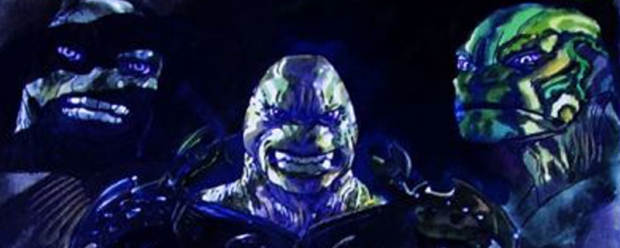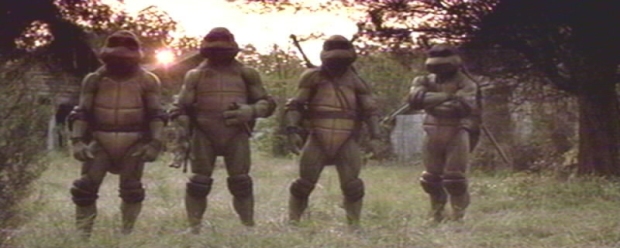Brendan McCarthy is an artists artist. A hero of mine following the discovery of his Visual Autobiography, Swimini Porpoise, in which he details almost exclusively in numerous artistic projects his stellar career from his time with Brett Ewins at Chelsea College, through to 2000AD and Hollywood. Realising I was sitting in a room with a man due to go for a drink with this legendary Practitioner’s Practitioner I almost yelped (in fact I may have). Friends with Destroy All Robot’s Darrin Grimwood they share a wry sideways view of the world through a spackled and myriad lens. McCarthy perpetuates his inner thoughts into accessible and engaging picture fields for your eyes to dance about in – possibly naked but almost certainly wearing a silly hat.
 A multifaceted pop artist from the very beginning of his career, Brendan McCarthy, unsurprisingly given his moniker, of Irish descent was born in London. Shortly afterwards (at an undisclosed age) he began to create his own home-made comics. Having left Chelsea Art College in London, where he found a penchant for sellotape murals incorporating various popular iconography and his own artwork and developed his distinctive and wild hearted style he moved on to creating Sometime Stories with his erstwhile partner in crime from college, Brett Ewins. His first paid work was Electric Hoax in the British Weekly music paper Sounds with Peter Milligan in 1978. He was snapped up, along with Ewins, to join the burgeoning 2000AD team at DC Thomson.
A multifaceted pop artist from the very beginning of his career, Brendan McCarthy, unsurprisingly given his moniker, of Irish descent was born in London. Shortly afterwards (at an undisclosed age) he began to create his own home-made comics. Having left Chelsea Art College in London, where he found a penchant for sellotape murals incorporating various popular iconography and his own artwork and developed his distinctive and wild hearted style he moved on to creating Sometime Stories with his erstwhile partner in crime from college, Brett Ewins. His first paid work was Electric Hoax in the British Weekly music paper Sounds with Peter Milligan in 1978. He was snapped up, along with Ewins, to join the burgeoning 2000AD team at DC Thomson.
Unstoppably driven – McCarthy was simultaneously drawing Judge Dredd for 2000AD and concept designing a Dan Dare Live Action Television series for Lew Grade’s ATV in the 1970s.
In 1980, inspired by the book the Razor’s Edge, McCarthy decided to travel the globe ‘on a futile and non-sensical metaphysical pilgrimage, ending up, via Egypt, India and the Himalayas, in Sydney, Australia.’ While there he witnessed the surfing lifestyle and extrapolated from it hybrid Mad Max of the waves concept that birthed the Peter Milligan penned ‘Freak Wave’ – a post apocalyptic surfing story.
Having preempted Waterworld by more than a decade returned to the UK and to drawing comics – most specifically the aptly named Strange Days, an Anthology title printed by Eclipse Comics – alongside his old counterparts Peter Milligan and Brett Ewins. His media-brat superhero Paradax escaped the pages of Strange Days to find a home in a two issue limited series and one of his best loved characters – Mirkin the Mystic ‘a kind of laconic, psychedelic, Ditko-esque, Oscar Wildean, inter dimensional traveller was born.
Introducing the Judda, an army of cloned Judges sent by Morton Judd, lunatic Stryfe-a-like and Brit Cit in the pages of Judge Dredd and the critcally acclaimed Sooner or Later with Milligan, which split opinion with its psychedelic and surreal content in the mid eighties, McCarthy began to branch out beyond his comic ken.
Around this time, Brendan designed and storyboarded the Arabian Cel-Animated TV series, New Babylon and also the Storyteller for Jim Henson’s production company. He also designed the character’s in Grant Morrison’s Zenith strip in 1987 and on Morrison and Millar’s brilliant Marvel Edge series Skrull Kill Krew (in which Skrull’s killed while in disguise as cows are processed as meat and fed to the local population; giving them Skrull like powers) and offered cover artwork and character design for Pete Milligan’s revamp of Shade: The Changing Man, clocking up yet more lunatic fringe story lines and productions to great public appeal and commercial success.
But even all of this paled in comparison to his new creations with 2000AD spin-off publications Crisis and Revolver. For Revolver McCarthy drew Rogan Gosh (later compiled into a single edition by Vertigo) and for Crisis he drew Skin, the tale of a thalidomide skinhead in 1970s London. Crisis and its publishers refused to use the story based on it being ‘morbidly obscene’. It was printed, finally in 1992 through Kevin Eastman’s (of Eastman and Laird) Tundra Publishing.
His most prominent work were as designer for the films Highlander, the first live action Teenage Mutant Ninja Turtles, Lost in Space and the Borrowers. He designed and contributed visual gags to the film, Coneheads, starring Dan Akroyd and David Spade.

The remainder of the 90s saw McCarthy working in television, most notably as designer of the break out CGI animated Science fiction TV series Reboot and character creator for War Planets. Reboot was a massive global success and the world’s first long-form computer animated piece, predating Pixar and Dreamwork’s later movies.
In 2003 he was asked to co-write and design Mad Max 4: Fury Road with director George Miller, also creating (with McCarthy listed as Co-writer and designer a surreal CGI animated feature).
In 2004, Brendan McCarthy took a years sabbatical and accidentally created the modern artist’s bible, Swimini Porpoise, an illustrated visual autobiography of his original art and design work, with the help of Steve Cook (artist, photographer, graphic designer). Released in 2005 in the UK as a limited artists edition it sold out within weeks. This very rare book is now considered a holy grail to collectors.
McCarthy featured in the final issue of DC Comics Solo, offering new takes on The Flash, Batman and Johnny Sorrow as well as creating a veritable menagerie of homeless, insane and transgendered social outcasts.
In April 2010, Spiderman: Fever was released through Marvel as a new take on Dr Strange.
It can be seen as bouncing professionally from one wild project to the next, McCarthy was easily recognised as the man to present lunacy in an easily digestible form (or take something digestable and make it lunatic). His career has never slowed but has ebbed in and out of public consciousness as his effect has been behind closed doors in many cases or never seen the light of day. His influences shining out of every panel and concept design combined with his innovative and practiced style gave depth and character to beings that otherwise deserve to sit on a psychological mind shelf kept for half formed thought forms – to witness a McCarthy image is to think you’ve had a fledgling memory about something you may have seen and thought was cool as a child though you cannot remember why or perhaps what it was made up of.
Whether a child-faced Death for Jim Henson, a Razor jawed villain in a CGI universe or an apocalyptic death race on the open seas McCarthy sees no limit and refuses to confine his ideas to previous practices and safe premises. As an artist I thank the stars he exists. A surreal and intelligently creative light. With a love of silly hats.



